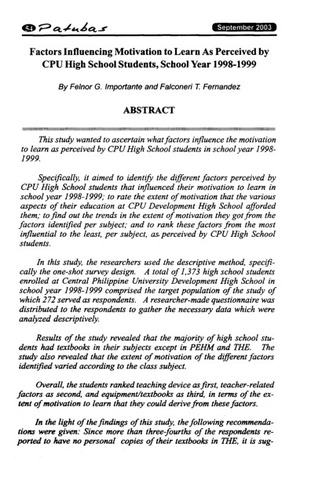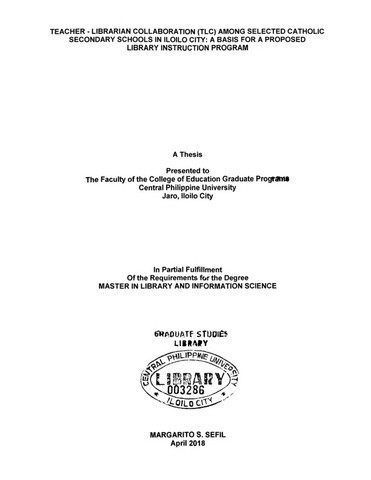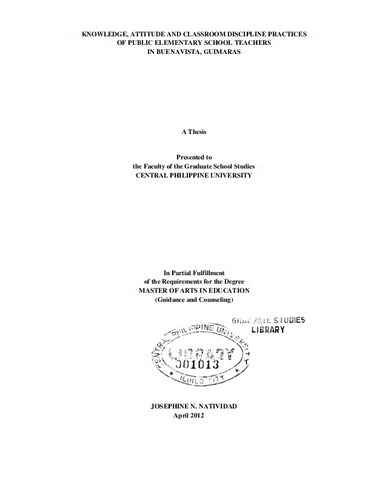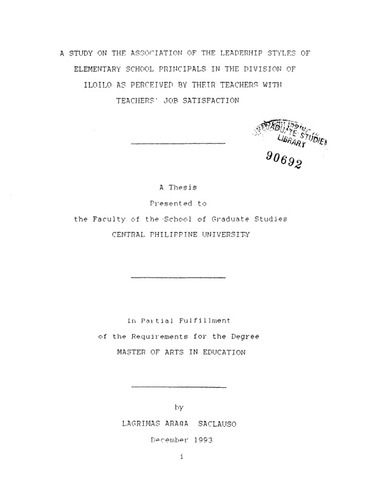Factors influencing motivation to learn as perceived by CPU High School students, School Year 1998-1999
Abstract
This study wanted to ascertain what factors influence the motivation to learn as perceived by CPU High School students in school year 1998-1999.
Specifically, it aimed to identify the different factors perceived by CPU High School students that influenced their motivation to learn in school year 1998-1999; to rate the extent of motivation that the various aspects of their education at CPU Development High School afforded them; to find out the trends in the extent of motivation they got from the factors identified per subject; and to rank these factors from the most influential to the least, per subject, as perceived by CPU High School students.
In this study, the researchers used the descriptive method, specifically the one-shot survey design. A total of 1,373 high school students enrolled at Central Philippine University Development High School in school year 1998-1999 comprised the target population of the study of which 272 served as respondents. A researcher-made questionnaire was distributed to the respondents to gather the necessary data which were analyzed descriptively.
Results of the study revealed that the majority of high school students had textbooks in their subjects except in PEHM and THE. The study also revealed that the extent of motivation of the different factors identified varied according to the class subject.
Overall, the students ranked teaching device as first, teacher-related factors as second, and equipment/textbooks as third, in terms of the extent of motivation to learn that they could derive from these factors.
In the light of the findings of this study, the following recommendations were given: Since more than three-fourths of the respondents reported to have no personal copies of their textbooks in THE, it is suggested that teachers recommend a textbook in the subject.
Since the extent of motivation of the different factors identified varied according to the class subject, it is recommended that the application of these should consider the nature of the subjects. The high regard of students for teacher’s notes on the blackboard and teacher's lecture support the talk and chalk approach to teaching and such should be encouraged with the complementation of other devices appropriate to the subject. The general high regard of students for all teacher-related factors, points out the need for the proper screening of teachers.
Description
Journal article
Associated Content
Research reportSuggested Citation
Importante, F. G., & Fernandez, F. T. (2003). Factors influencing motivation to learn as perceived by CPU High School students, School Year 1998-1999.Type
ArticleISSN
1908-515XSubject(s)
Keywords
Collections
- Journal articles [11]
- Patubas [110]
Related items
Showing items related by title, author, creator and subject.
-
Teacher - Librarian Collaboration (TLC) among selected catholic secondary schools in Iloilo City: A basis for a proposed library instruction program
Sefil, Margarito S. (2018)This is a quantitative research which aimed to determine the level of TLC and the factors associated with it among the Catholic secondary schools in Iloilo City. It utilized self-administered survey instruments for teachers ... -
Knowledge, attitude and classroom discipline practices of public elementary school teachers in Buenavista, Guimaras
Natividad, Josephine N. (2012)Classroom discipline is the process of correcting and moulding the mental faculties and moral characters of pupils inside the classroom. Teachers are the main actors in imposing classroom discipline. The success of the ... -
A study of the association of the leadership styles of elementary school principals in the Division of Iloilo as perceived by their teachers with teachers' job satisfaction
Saclauso, Lagrimas Araña (1993)It is the purpose of this study to go into the leadership styles of elementary school principals as seen by themselves and by their teachers. It is hoped that leaders and their subordinates jointly discover ways by which ...





